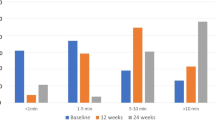Abstract
This study was carried out to document the long-term results of postanal repair for idiopathic faecal incontinence. Thirty-one patients (mean age 65.6 years) were followed up for 2–7.5 years (median 4.2 years). Continence was improved in 16 (52%) patients, only 2 (6%) of whom regained normal continence. No significant change in resting anal pressure, maximum squeeze pressure, pelvic descent or anorectal angle was seen postoperatively. The electromyographical signs, e.g. duration and amplitude of action potentials, average amplitude, and integrals of the curves did not change significantly after the operation. The mean right pudendal nerve terminal motor latency (PNTML) increased from 2.38 ms before to 2.59 ms after surgery (P>0.05). No significant change in the continence and defaecation index was seen postoperatively.
Zusammenfassung
Diese Studie untersucht die funktionellen Langzeitergebnisse der posterioren Raffung bei der idiopathischen Inkontinenz. Einunddreiβig Patienten mit einem Durchschnittsalter von 65,6 Jahren wurden nach 2 bis 7 1/2 Jahren (durchschnittliches Follow-up 4,2 Jahre) nachuntersucht. Bei 16 Patienten (52%) kam es zu einer Verbesserung der Kontinenzleistung, allerdings nur 2 Patienten (6%) erlangten die komplette Kontinenz. Es wurde postoperativ keine signifikante Veränderung in bezug auf den Ruhe- und Kontraktionsdruck, die Beckenbodenebene und den anorektalen Winkel beobachtet. Die elektromyographischen Zeichen wie Aktionspotentialdauer, Höhe der Amplitude, der durchschnittliche Amplitudenmittelwert und das Integral zeigten postoperativ keine signifikante Veränderung. Die mittlere terminale motorische Latenz des rechten N. pudendus (PNTML) verlängerte sich von 2,38 ms präoperativ auf 2,59 ms postoperativ (p>0,05). Der Kontinenz- und Defäkationsindex zeigte postoperativ keine signifikante Veränderung.
Similar content being viewed by others
Literatur
Athanasiadis S (1992) Elektromyographische Befunde an der Beckenbodenmuskulatur von Patienten mit anorektaler Inkontinenz. Chirurg 63:822
Athanasiadis S, Sanchez M, Nafe M (1994) Ergebnisse der anterioren Levator- und Externusplastik bei der idiopathischen anorektalen Inkontinenz. Eine prospektive manometrische, elektromyographische und radiologische Studie. Chirurg 65:634
Athanasiadis S, Heiligers J, Kossivakis D (1992) Anteriore und posteriore Rektopexie mit Levatorraffung bei Patienten mit Rektumprolaps und Inkontinenz. Langenbecks Arch Chir 377:288
Athanasiadis S, Heiligers J (1993) Der Wert der abdominellen Rektopexie bei obstruktiven Defäkationsstörungen. Langenbecks Arch Chir 378:92
Bartold DCC, Jarratt JA, Read NW (1983) The use of conventional electromyography to asses external anal sphincter neuropathy in man. J Neurol Neurosurg Psychiatry 46:115
Bartold DCC, Jarratt JA, Read MG, Donnelly TC, Read NW (1983) The role of partial denervation of the puborectalis in idiopathic faecal incontinence. Br J Surg 70:664
Beersiek F, Parks AG, Swash M (1979) Pathogenesis of anorectal incontinence: a histometric study of the anal canal musculature. J Neurol Sci 42:111
Braun J, Töns CH, Schippers E, Faβ J, Schumpelick V (1991) Ergebnisse der posterioren Raffung nach Parks bei der idiopathischen analen Inkontinenz. Chirurg 62:206
Browning GGP, Parks AG (1983) Postanal repair for neuropathic faecal incontinence: correlation of clinical results and anal canal pressures. Br J Surg 70:101
Girona J, Serena A, Athanasiadis S (1984) Der Stellenwert des “post anal repair” in der chirurgischen Behandlung der analen Inkontinenz. In: Fartmann EH, Fiedler L (Hrsg) Die anale Inkontinenz und ihre Wiederherstellung. Urban & Schwarzenberg, München, S 112
Henry MM, Simpson JNL (1985) Results of postanal repair: a prospective study. Br J Surg 72 [Suppl]:517
Jameson JS, Speakmann CTM, Darzi A, Chui YW, Henry MM (1993) Long term results of postanal repair for idiopathic faecal incontinence. Gut 33 [Suppl]:58
Jorge JM, Wexner SD, Ehrenpreis E, Nogueras JJ, Jagelmann DG (1992) Does perineal descent correlate with pudendal neuropathy? Dis Colon Rectum 35:P11
Keighley MRB (1984) Postanal repair for faecal incontinence. JR Soc Med 77:285
Kiff ES, Swash M, Barnes PRH (1984) Evidence of pudendal neuropathy in patients with perineal descent and chronic straining at stool. Gut 25:1279
Laurberg S, Swash M, Henry MM (1990) Effect of postanal repair on progress of neurogenic damage to the pelvic floor. Br J Surg 77:519
Mann CV, Glass RE (1991) Surgical treatment of anal incontinence. Springer, Berlin Heidelberg New York Tokyo
Miller R, Bartolo DCC, Locke-Edmunds JC, Mortensen NJ (1988) Prospective study of conservative and operative treatment for faecal incontinence. Br J Surg 75:101
Neill ME, Parks AG, Swash M (1981) Physiological studies of the anal sphincter musculature in faecal incontinence and rectal prolapse. Br J Surg 68:531
Parks AG (1975) Anorectal incontinence. Proc R Soc Med 68:681
Parks AG, Swash M, Ulrich H (1977) Sphincter denervation in anorectal incontinence and rectal prolapse. Gut 18:656
Rainey JB, Donaldson DR, Thomson JPS (1990) Postanal repair: which patients derive most benefit? J R Col Surg 35:101
Setti-Carraro P, Kamm MA, Nicholls PJ, McGee S, Bartram CJ (1993) Six year follow-up of postanal repair for neurogenic faecal incontinence: outcome, predictive factors, and role of occult sphincter defects demonstrate by ultrasonography. Gut 33 [Suppl]:65
Scheuer M, Kuijpers JHC, Jacobs PP (1989) Postanal repair restores anatomy rather than function. Dis Colon Rectum 32:960
Schuten WR, Briel JW (1993) Late results of postanal repair: a retrospective study. Br J Surg 80 [Suppl]:88
Scott ADN, Henry MM, Phillips RKS (1990) Clinical assessment and anorectal manometry before postanal repair: failure to predict outcome. Br J Surg 77:629
Yoshioka K, Keighley MRB (1989) Critical assessment of the quality of continence after postanal repair for faecal incontinence. Br J Surg 76:1054
Womack NR, Morrison JFB, Williams NS (1988) Prospective study of the effects of postanal repair in neurogenic faecal incontinence. Br J Surg 75:48
Stricker JW, Schoetz DJ, Coller JA, Veidenheimer MC (1988) Surgical correction of anal incontinence. Dis Colon Rectum 31: 533–540
Author information
Authors and Affiliations
Rights and permissions
About this article
Cite this article
Athanasiadis, S., Sanchez, M. & Kuprian, A. Langzeitergebnisse der posterioren Raffung nach Parks Eine elektromyographische, manometrische und radiologische studie bei 31 patienten. Langenbecks Arch Chir 380, 22–30 (1995). https://doi.org/10.1007/BF00184412
Received:
Published:
Issue Date:
DOI: https://doi.org/10.1007/BF00184412




